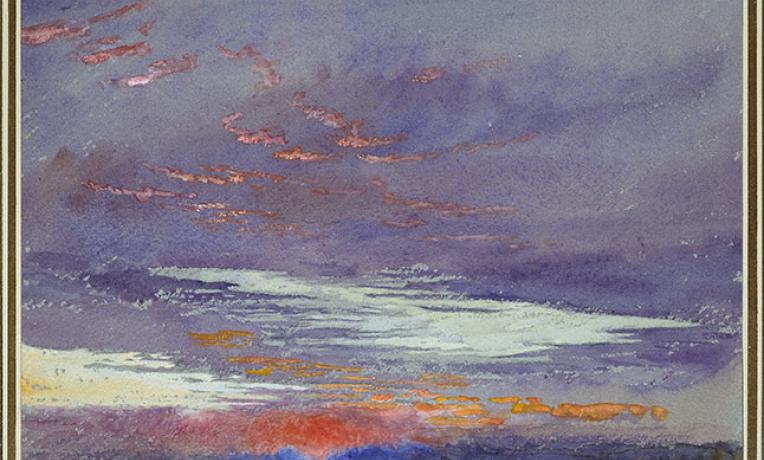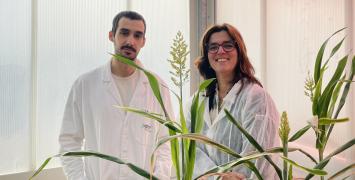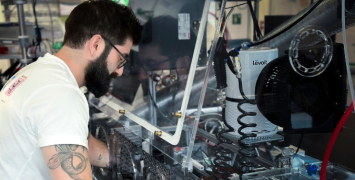From the Industrial Revolution to the ‘colour revolution’
Far from being simply a matter of taste, colour is a central aspect of culture, whether past or present. This is particularly true of the Victorian age (1837-1901), during which a ‘colour revolution’ took place following the invention of the first artificial coal-tar dyes. New attitudes towards colour production and perception shaped art and literature movements all over Europe. ERC grantee Charlotte Ribeyrol studies this key period from an interdisciplinary perspective.

Although we tend to associate the Industrial Age with the darkness of coal, people’s experience and perception of colour underwent a significant change in the second half of the 19th century when chemists managed to synthesize the first aniline dyes from coal. This ‘chromatic turn’ led in particular to new perspectives and practices regarding the use of colour in a wide range of artistic fields, from painting to fashion, sculpture and the decorative arts.
“Visual artists have always been interested in colour, but now it caught the interest of poets too, who often belonged to the same artistic circles – like William Morris or Oscar Wilde”, explains Charlotte Ribeyrol, Associate Professor at the Sorbonne in Paris and the principal investigator of the ERC-funded CHROMOTOPE project. “In the poetry of the past, colour terms were rather rare or conventional. But in the second half of the 19th century, new and often technical words like ‘mauve’, ‘solferino’ or ‘cinnabar’ appeared in literary texts, in keeping with the new colours which chemists were then devising for an expanding textile industry. This reveals new forms of interest in chromatic matter, which to this day has never been analysed from an interdisciplinary perspective .”
Bringing in modern chemistry
Modern chemistry offers state-of the-art techniques to analyse the pigments and dyes used at that time. Ribeyrol works with an international team of chemists based at the Conservatoire National des Arts et Métiers (CNAM) in Paris and the Ashmolean Museum of Art and Archaeology in Oxford – Britain’s oldest public museum, founded in 1683. Their analyses are shedding invaluable light on the toxicity and evolution of pigments and dyes through time, which was a key interest of 19th century poets and artists alike.
One object, which the Oxford CHROMOTOPE team is currently exploring is the Great Bookcase (1862) of William Burges, one of England's most notable architects under Queen Victoria’s reign. The bookcase is decorated with colourful panels, painted by no fewer than 14 major British artists, illustrating both the pagan and Christian origins of art. “Unfortunately the pandemic delayed many of these analyses, which could not be carried out remotely. Although this was initially a serious challenge to the interdisciplinary exchange, we are now back on track,” says Ribeyrol. “What’s fascinating about this bookcase, as our chemist Tea Ghigo has shown, is that its panels depicting classical and medieval stories are coloured with modern pigments. Here the colours of the past merge with the colours of modernity”.
New creative horizons
Burges and his artist friends were also very interested in fashion, both past and present. The ‘colour revolution’ made colourful clothes and accessories accessible to all, especially to women from all social backgrounds. “But women were not simply passive consumers of these new hues; they also wrote about colour in magazines and scientific journals and used them in innovative ways in their own artistic creations, from painting to tapestry”, says Ribeyrol. “Men, on the other hand, were expected to wear black, to the great dismay of artists and poets like the French writer Charles Baudelaire who, for this very reason, described his own century as ‘funereal’.”
Colour nonetheless, pervades the works of Romantic and post-Romantic writers and artists across Europe. For Baudelaire and others poets and artists like Morris – who is especially known for his wallpaper designs - the progressive emancipation of colour from form and realistic considerations opened up new creative horizons.
Watching this video you are accepting Youtube cookies policy
An ambitious exhibition
A major exhibition organized by Ribeyrol and her colleagues, which is scheduled to open at the Ashmolean Museum in September 2023, will shed light on this remarkable period in the arts. The idea for the exhibition arose during a conference in 2017, explains Ribeyrol. “We showed the participants some of the most colourful 19th century drawings and watercolours in the museum print-room, from D.G. Rossetti to Paul Cézanne. Their very positive response encouraged us to suggest Victorian colour as the theme for a more ambitious exhibition, which would showcase our ongoing research. This will be a key moment for the CHROMOTOPE project which will hopefully spur new interest in the 19th century and more generally in the emerging field of colour and material studies.”
"Everybody can relate to colour, whatever their age, gender or culture”, Ribeyrol continues. “This is what is so stimulating and challenging about this multifaceted topic. Our aim with CHROMOTOPE is to show that the Victorians did not live in a gloomy world. The way they embraced the changing colours of their everyday world sheds light on how they felt about key issues such as race, class, religion and gender – many of these questions being still relevant today."
BIO
Charlotte Ribeyrol is Associate Professor in 19th century British literature at Sorbonne Université in Paris and a member of the Institut Universitaire de France. Her main field of research is Victorian Hellenism and the reception of the colours of the past in Victorian painting and literature. In 2014-2016, she co-directed a major interdisciplinary project on chromatic materiality (POLYRE, IDEX Sorbonne Universités) with chemists and archaeologists, which led to the publication of a collection of essays entitled The Colours of the Past in Victorian England (Peterlang, Oxford, 2016). Following her Marie Sklodowska Curie Fellowship (COPAST) at Oxford she was awarded an ERC Consolidator Grant to explore the 19th century ‘chromatic turn’ in her project CHROMOTOPE.






